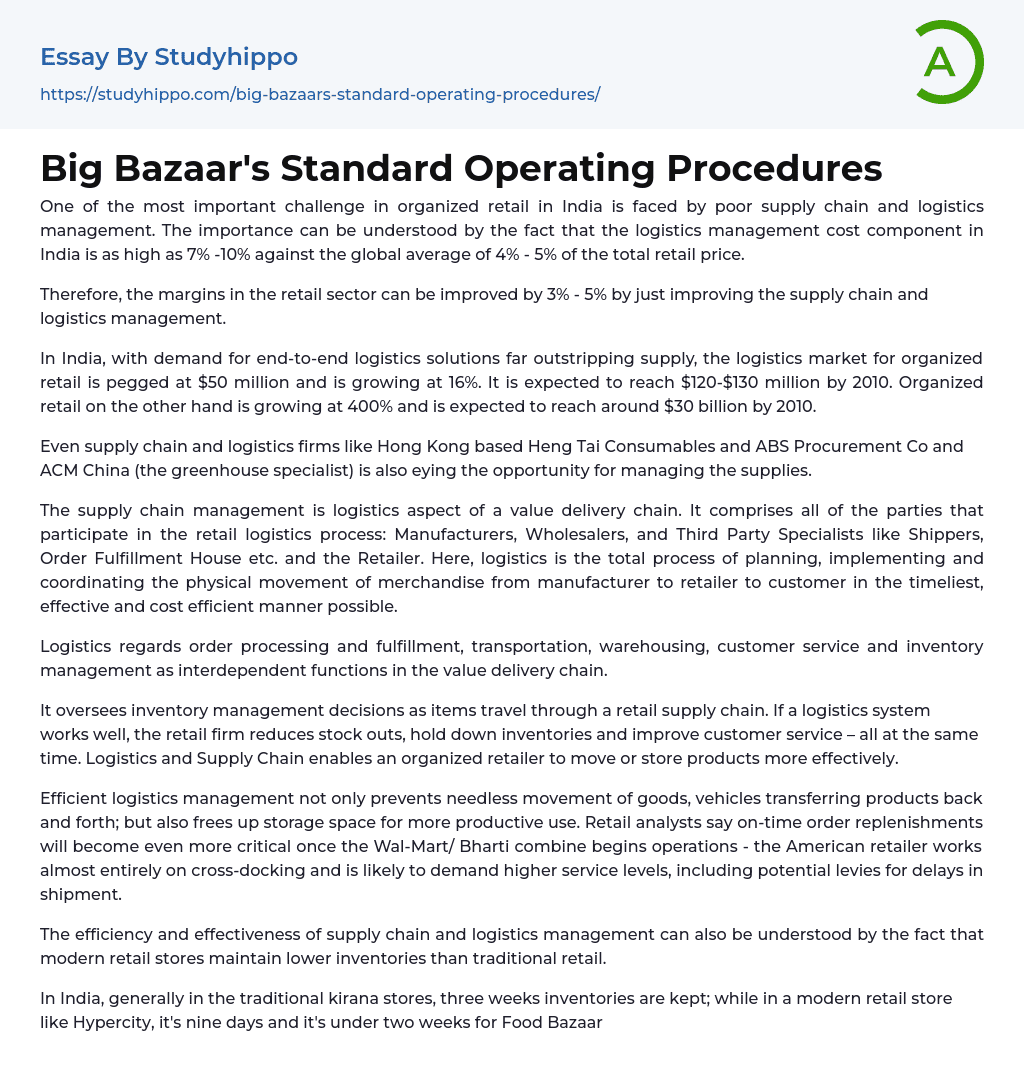One of the most important challenge in organized retail in India is faced by poor supply chain and logistics management. The importance can be understood by the fact that the logistics management cost component in India is as high as 7% -10% against the global average of 4% - 5% of the total retail price.
Therefore, the margins in the retail sector can be improved by 3% - 5% by just improving the supply chain and logistics management.
In India, with demand for end-to-end logistics solutions far outstripping supply, the logistics market for organized retail is pegged at $50 million and is growing at 16%. It is expected to reach $120-$130 million by 2010. Organized retail on the other hand is growing at 400% and is expected to reach around $30 billion by 2010.
Even supply chain and logistics firms like Hong Kong based Heng Tai Consumables and ABS Procurement Co and ACM China
...(the greenhouse specialist) is also eying the opportunity for managing the supplies.
The supply chain management is logistics aspect of a value delivery chain. It comprises all of the parties that participate in the retail logistics process: Manufacturers, Wholesalers, and Third Party Specialists like Shippers, Order Fulfillment House etc. and the Retailer. Here, logistics is the total process of planning, implementing and coordinating the physical movement of merchandise from manufacturer to retailer to customer in the timeliest, effective and cost efficient manner possible.
Logistics regards order processing and fulfillment, transportation, warehousing, customer service and inventory management as interdependent functions in the value delivery chain.
It oversees inventory management decisions as items travel through a retail supply chain. If a logistics system works well,
the retail firm reduces stock outs, hold down inventories and improve customer service – all at the same time. Logistics and Supply Chain enables an organized retailer to move or store products more effectively.
Efficient logistics management not only prevents needless movement of goods, vehicles transferring products back and forth; but also frees up storage space for more productive use. Retail analysts say on-time order replenishments will become even more critical once the Wal-Mart/ Bharti combine begins operations - the American retailer works almost entirely on cross-docking and is likely to demand higher service levels, including potential levies for delays in shipment.
The efficiency and effectiveness of supply chain and logistics management can also be understood by the fact that modern retail stores maintain lower inventories than traditional retail.
In India, generally in the traditional kirana stores, three weeks inventories are kept; while in a modern retail store like Hypercity, it's nine days and it's under two weeks for Food Bazaar. Now, it is beneficial for both the manufacturer as well as the retailer. If we go through the following food supply chain in India, we find that a lot can be improved by maintaining the supply chain and logistics. heir availability on a relatively large scale and supplying them to customers on a relatively small scale. Retailer is a Person or Agent or Agency or Company or Organization who is instrumental in reaching the Goods or Merchandise or Services to the End User or Ultimate Consumer. The logistics industry in India is evolving rapidly and it is the interplay of infrastructure, technology and new types of service providers that will define whether the industry is
able to help its customers reduce their logistics costs and provide effective services (which are also growing).
Changing government policies on taxation and regulation of service providers are going to play an important role in this process. Coordination across various government agencies requires approval from multiple ministries and is a road block for multi modal transport in India. At the firm level, the logistics focus is moving towards reducing cycle times in order to add value to their customers. Consequently, better tools and strategies are being sought by firms in order to enhance their decision making.
Some Peculiarities of the Indian Supply Chains
The Indian logistics sector has typically been driven by the objective of reducing transportation costs that were (and often continue to be) inordinately high due to regional concentration of manufacturing and geographically diversified distribution activities as well as inefficiencies in infrastructure and accompanying technology. Freight movement has slowly been shifting from rail to road with implications on quality of transfer, timeliness of delivery and consequently costs except for commodities which over long distances, predominantly, move through the extensive rail network.
- Auction essays
- Balanced Scorecard essays
- Business Plans essays
- Expense essays
- Income essays
- Net Income essays
- Security Guard essays
- Singapore Airlines essays
- Battle essays
- Intranet essays
- Maintenance essays
- Simulation essays
- Inn essays
- Chief Executive Officer essays
- Convenience Store essays
- Firm essays
- Training And Development essays
- Unilever essays
- Variable Cost essays
- Virgin Group essays
- Bargaining essays
- Entity essays
- Pest analysis essays
- Value Chain essays
- Airbus essays
- Delta Air Lines essays
- Qantas essays
- Accounting essays
- Andrew Carnegie essays
- Automation essays
- Business Cycle essays
- Business Intelligence essays
- Business Model essays
- Business Operations essays
- Business Software essays
- Cooperation essays
- Cooperative essays
- Corporate Social Responsibility essays
- Corporation essays
- Customer Relationship Management essays
- Family Business essays
- Franchising essays
- Harvard Business School essays
- Harvard university essays
- Human Resource Management essays
- Infrastructure essays
- Inventory essays
- Logistics essays
- Management essays
- Manufacturing essays




